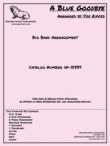JAZZ IMPROVISATION: A WHOLE-BRAIN APPROACH [DOWNLOAD]
Joe Riposo
Cat #: JA-WBA-DL
$19.95This product is available for immediate download after purchase.
Questions?
Please call +1-518-587-1102 or email us.
Edition: PDF
Publisher: Jamey Aebersold Jazz
JAZZ IMPROVISATION "A Whole Brain Approach " is the result of 20 years of searching for a successful method for teaching jazz improvisation and research in hemisphericity as it relates to jazz improvisation. It is applicable for middle school, high school, college level classes and studio instructional programs.
This text will also provide jazz instructional techniques for those in music education teacher preparation programs. As a high school student. I can remember my bewilderment when I realized some of my fellow students could not play without the use of printed music while others could play music quite well by ear. This difference raised several questions in my mind.
When I entered college as a music major, my bewilderment continued because it seemed that the more theoretical knowledge the students obtained, the more restricted they became in their ability to perform music by ear.
Observing this phenomena brought about some interesting notions. Two basic questions came into focus; how does the brain process information and how does learning take place?
I began to read a number of books about hemisphericity and split-brain studies. Although the research at that time was mainly concerned with brain damaged patients, results were documented which produced specific conclusions important to the understanding of how the brain processes information. As a result of numerous split-brain operations performed in the '60s, a surge of research became available documenting specialized functions of the left and right brain.
Among psychologists, interest in what part of the brain controlled various functions of human behavior dramatically increased. They became more interested in developing a better understanding of the learning process. As I started to relate these concepts to the learning of improvisation, I developed specific concepts for teaching improvisation.
Since I began teaching composition and jazz improvisation a number of traditionally trained music students expressed a desire to learn to improvise. As a result of their participation in my classes, they became knowledgeable about scales, chord progressions, and harmonic and theoretical concepts involved in developing the skill of improvisation. Somehow they still found it difficult to improvise with a degree of self-satisfaction. Their improvised line sounded contrived and often mechanical. I believe this is a result of their inability to shift from improvising in the left brain through the use of knowledge to improvising in the right brain through the use of expressing one's feelings. I further discovered that some students quickly learn to improvise and show a greater degree of maturtty when just a few basic concepts and ideas are demonstrated. This perhaps is achieved because these students were able to develop a mental picture of what is needed to make the mental shift from improvising in the left brain to improvising in the light brain.
By using teaching techniques formulated as a result of this discovery has produced students who are able to improvise in a more imaginative fashion.
You will find the material in this book much like the material presented in most books aimed at the teaching of jazz improvisation. However, this book presents the learning of improvisation through developing an understanding of the whole-brain approach.
The unique difference is the approach used to develop an understanding of this mental process. The process used to teach creativity is clearly identified and labeled through out the book.
With the introduction of each new concept, you are reminded of the specialized function of the four basic quadrants of the brain as related to improvisation. It is the understanding of this process that will produce improvisors who can use the theoretical information presented as applicable knowledge and unfasten their creative potential.

![JAZZ IMPROVISATION: A WHOLE-BRAIN APPROACH [DOWNLOAD] JAZZ IMPROVISATION: A WHOLE-BRAIN APPROACH [DOWNLOAD]](https://s3.amazonaws.com/jazzbooks.com/product-images/D-WBA.jpg)





![BLUE GOODBYE, A [DOWNLOAD]](https://www.ejazzlines.com/wp-images/product/thumbnail/w51540.jpg)

